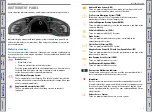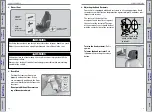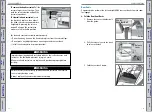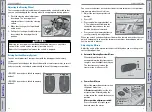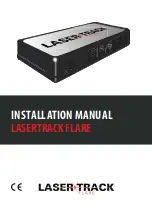
20 |
| 21
SAFETY
SAFETY
n
Protecting Infants
An infant must be properly restrained in a rear-facing, reclining child seat
until the infant reaches the seat manufacturer’s weight or height limit for the
seat, and the infant is at least one year old. Many experts recommend use
of a rear-facing seat for a child up to two years old if the child’s height and
weight are appropriate for a rear-facing seat.
Child seats must be placed and
secured in a rear seating position.
Rear-facing child seats should never
be installed in a forward-facing
position.
When properly installed, a rear-facing child seat may prevent the driver or
a front passenger from moving their seat all the way back, or from locking
their seat-back in the desired position. Make sure that there is no contact
between the child seat and the seat in front of it. It can also interfere with
proper operation of the front passenger’s advanced front airbag system. If
this occurs, we recommend that you install the child seat directly behind the
front passenger’s seat, move the seat as far forward as needed, and leave it
unoccupied. Or, you may wish to get a smaller rear-facing child seat.
Allowing a child to play with a seat belt or wrap one around their neck
can result in serious injury or death.
Instruct children not to play with any seat belt and make sure any unused
seat belt a child can reach is buckled, fully retracted, and locked.
WARNING
Placing a rear-facing child seat in the front seat can result in serious
injury or death during a crash.
Always place a rear-facing child seat in the rear seat, not the front.
WARNING
n
Protecting Smaller Children
If a child is at least one year old and within the weight range indicated by
the child seat manufacturer, the child should be properly restrained in a
firmly secured forward-facing child seat.
We strongly recommend placing a forward-
facing child seat in a rear seating position.
Placing a forward-facing child seat in the front
seat can be hazardous, even with advanced front
airbags that automatically turn the passenger’s
front airbag off. A rear seat is the safest place for
a child.
Placing a forward-facing child seat in the front seat can result in serious
injury or death if the front airbag inflates.
If you must place a forward-facing child seat in front, move the vehicle
seat as far back as possible, and properly restrain the child.
WARNING
n
Selecting a Child Seat
Most child seats are LATCH-compatible (Lower Anchors and Tethers for
CHildren). Some have a rigid-type connector, while others have a flexible-
type connector. Both are equally easy to use. Some existing and previously
owned child seats can only be installed using the seat belt. Whichever type
you choose, follow the child seat manufacturer’s use and care instructions
as well as the instructions in this manual. Proper installation is key to
maximizing your child’s safety.
In seating positions and vehicles not equipped with LATCH, a LATCH-
compatible child seat can be installed using the seat belt and a top tether
for added security. This is because all child seats are required to be
designed so that they can be secured with a lap belt or the lap part of a lap/
shoulder belt. In addition, the child seat manufacturer may advise that a
seat belt be used to attach a LATCH-compatible seat once a child reaches
a specified weight. Please read the child seat owner’s manual for proper
installation instructions.
Important considerations when selecting a child seat
Make sure the child seat meets the following three requirements:
• The child seat is the correct type and size for the child.
• The child seat is the correct type for the seating position.
• The child seat is compliant with Federal Motor Vehicle Safety Standard 213.



















